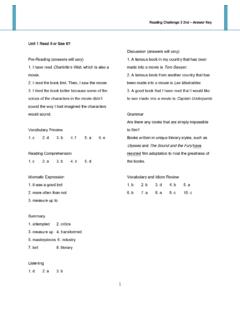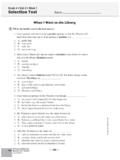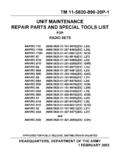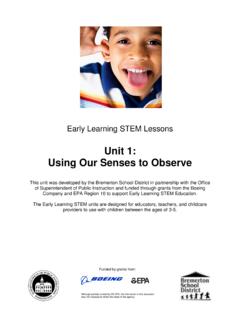Transcription of UNIT ONE Welcome! - Sign Media
1 unit One Objectives To learn proper greetings and farewells in ASL To introduce yourself and others To learn basic ASL sentence structure To ask and answer questions To learn how to interact appropriately with Deaf people To learn the role of facial expressions and non-manual signalsUNIT ONEW elcome! 2 unit ONE Welcome! unit One Vocabularyto beAbsent ..30 Afternoon ..7 Again, repeat ..17 American SignLanguage ..17 Bathroom ..17 Blank face ..26to beBored ..26to beBusy ..5 Can, may ..29 Can t, may not ..29to beConfused ..5 Deaf ..12 Deixis.
2 6 Don t know ..29 Don t like ..29 Don t understand ..29 Due, to owe ..30 Evening, night ..7to beExcited ..26 Eye contact ..8 Facial expressions ..26 Favorite ..30 Fine ..5 Focus, pay attention ..8 Friend ..12toGo to ..17to beGood, well ..5 Good-bye ..20 Handwave ..14to beHappy ..5 Hard of hearing ..12He / she / it ..6 Hearing ..12 Hello ..4Hi ..4 Hold on ..8 Homework ..8I am, me ..6I don t mind ..30I m not, not me ..29toIntroduce ..12toKnow ..29 Last ..10 Later ..20toLearn ..17toLike ..29 Look at me ..8to beMad, angry.
3 26Me too, same here ..20toMeet ..12 Morning ..7 Movie ..30My ..12 Name ..10 Nice ..12 NMS: Head nod ..28 NMS: Head shake ..28 NMS: Question-Maker .15No ..17No eye contact ..8 Nothing, not much ..5 Please ..17to Practice ..30to beSad ..26 Same old, the usual ..5to beScared, afraid ..26 School ..30toSee ..20 Shoulder tap ..14to beSick ..26toSign, sign language ..17to beSleepy ..5 Slow, to slow down ..17So-so ..5 Take care ..20 Thank you ..17 They are ..6to beTired ..5 Today, now ..30 Tomorrow ..20 Turn off voice ..14toUnderstand.
4 29toWant ..12We are, us ..6 What s up ..4 Yes ..17 You are ..6 You are (plural) ..6 Key PhrasesHow are you? ..4I m fine ..4 Nice to meet you ..12 See you later ..20 See you tomorrow ..20 What is your name? ..9 What s for homework? ..83 welcome ! unit ONEIn her role as an ASL teacher, Rita presents information that focuses onASL grammar and Deaf culture, gives tips on how to improve yoursigning, and answers common questions students have about example, a frequent questions is: What is the differencebetween deafandDeaf? When deaf is not capitalized, it describesone s hearing status.
5 When capitalized, Deaf describes those individuals who are proud to be deaf and consider themselves members of the Deaf culture. They use American sign Language astheir preferred means of characters highlighting the variety of backgrounds within the Deaf community are profiled throughoutMaster ASL! Level will present useful vocabulary, highlight aspects of Deaf culture, and share theiraccomplishments and interests. You will realize that the lives of Deaf people are very much like your lives in Boston, Massachusetts, and is the onlyDeaf person in his family.
6 Originally from Texaswhere he attended the Texas School for the Deaf,he now attends a public school and uses sign lan-guage interpreters in his classes. Marc, his brother, and a younger sister are Deaf;his mother is hard of hearing, and his father ishearing. He plays football at a school for theDeaf, is a member of the speech and debate teamand is involved in student government. He planson attending Gallaudet University, the world sonly university for Deaf , like Sean,is the onlyDeaf person inher family,though sheconsiders her-self lucky becauseher parents andolder brother all learnedAmerican sign Language.
7 Kellyenjoys drama, photography, and spending time onher creative writing. She wants to teach Deaf childrenafter college. A pet peeve? When hearing people say, I lltell you later or It s not important. Kris is a university student studying government and lawwhose siblings, parents, andgrandparents are all Deaf. An avid athlete, she lovesto snowboard, ski, andplay tennis. When she isn t studying, she can befound spending time with her family and isespecially fond of story-telling competitions. KRISSEANKELLYMARCRITAMeet the Characters4 unit ONE welcome !
8 GreetingsWhen signing to a friend, sign Hi!, butwith adults or people you don t knowwell, use the more formal you want to be formal orcasual, accompanying the sign with asmile means a lot to both Deaf andhearing people! What s up?is aninformal way to ask How are you?inboth American sign Language andEnglish. You can also sign What s up?one-handed, but both signs must include raising your chin. Hello!Hi!What s up?What s up? How are you?I m are you?5 welcome ! unit ONE1 Hello! Exchange greetings with a classmate and ask how he or she is are you? Ask a partner to tell you how another classmate is Look at the list of people in italics.
9 Would you use What s up?or How are you? to greetthem? ASL ASL Exercise To be busyConfusedFineTo be good, well To be happyNothing, not muchSame old, the usualSleepySo-soTo be tiredAHowareyou?&What sup?How is he /she?He /she is ONE Welcome! ASL Up CloseDeixisI am, meYou areHe, she, it isWe are, usYou are (plural)They arePointing is a logical feature ofa signed, non-spoken is not considered rude orimpolite. If a person or objectis not visible, point to anempty space and continuesigning. Using the index fingerto point is called Exercise BFYIDon t forget to point backto the sign Language is of great value to the deaf, but could also be of great benefit tothe hearing as It is superior to spoken language in its beauty and emotional expressiveness.
10 It brings kindred souls into a much more close and conscious communionthan mere speech can possibly do. Thomas H. Gallaudet, 1848 How is everybody? sign each sentence in ASL following the example. Use deixis as Verbs: To are s is m am s are s fine. I m not too bad7 welcome ! unit ONEV ocabularyMoreGreetingsClassroom Exercise C1 Greetings. Greet your classmates and ask how they are Work with a partner to sign a dialogue using vocabulary you ve learned. 3 What time of day is it? Is it afternoon, evening, or morning in each illustration?







